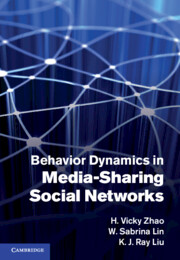Book contents
- Frontmatter
- Contents
- Preface
- Part I Introduction
- Part II Behavior forensics in media-sharing social networks
- Part III Fairness and cooperation stimulation
- 8 Game-theoretic modeling of colluder social networks
- 9 Cooperation stimulation in peer-to-peer video streaming
- 10 Optimal pricing for mobile video streaming
- Part IV Misbehaving user identification
- Part V Media-sharing social network structures
- References
- Index
9 - Cooperation stimulation in peer-to-peer video streaming
from Part III - Fairness and cooperation stimulation
Published online by Cambridge University Press: 28 April 2011
- Frontmatter
- Contents
- Preface
- Part I Introduction
- Part II Behavior forensics in media-sharing social networks
- Part III Fairness and cooperation stimulation
- 8 Game-theoretic modeling of colluder social networks
- 9 Cooperation stimulation in peer-to-peer video streaming
- 10 Optimal pricing for mobile video streaming
- Part IV Misbehaving user identification
- Part V Media-sharing social network structures
- References
- Index
Summary
In the previous chapter, we used colluders in multimedia fingerprinting as an example to study the necessary conditions for colluders to cooperate with one another, and investigated how attackers negotiate with one another and reach an agreement. In this chapter, we consider P2P networks, investigate how users in P2P systems cooperate with one another to form a social network, and study the optimal cooperation strategies.
As introduced in Chapter 3, mesh-pull–based P2P video streaming is one of the largest types of multimedia social networks on the Internet and has enjoyed many successful deployments. However, because of the voluntary participation nature and limited resources, users' full cooperation cannot be guaranteed. In addition, users in P2P live streaming systems are strategic and rational, and they are likely to manipulate any incentive systems (for example, by cheating) to maximize their payoffs. As such, in this chapter, we study the incentives for users in video streaming systems to collaborate with one another and design the optimal cooperation strategies.
Furthermore, with recent developments in wireless communication and networking technologies and the popularity of powerful mobile devices, low-cost and high-quality–service wireless local area networks (WLANs) are becoming rapidly ingrained in our daily lives via public hotspots, access points, digital home networks, and many others. Users in the same WLAN form a wireless social network; such wireless social networks have many unique properties that make cooperation stimulation more challenging.
- Type
- Chapter
- Information
- Behavior Dynamics in Media-Sharing Social Networks , pp. 169 - 194Publisher: Cambridge University PressPrint publication year: 2011



